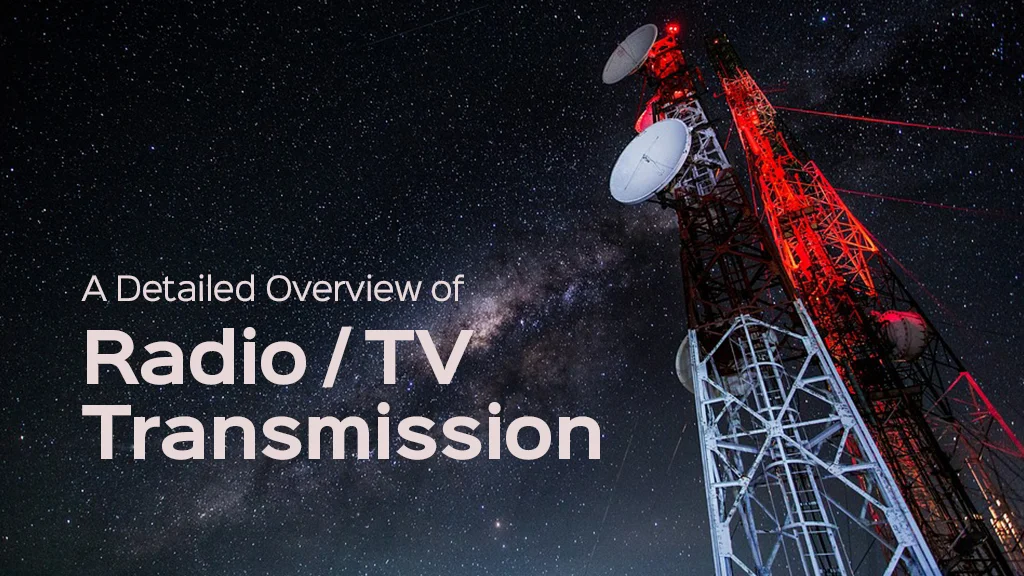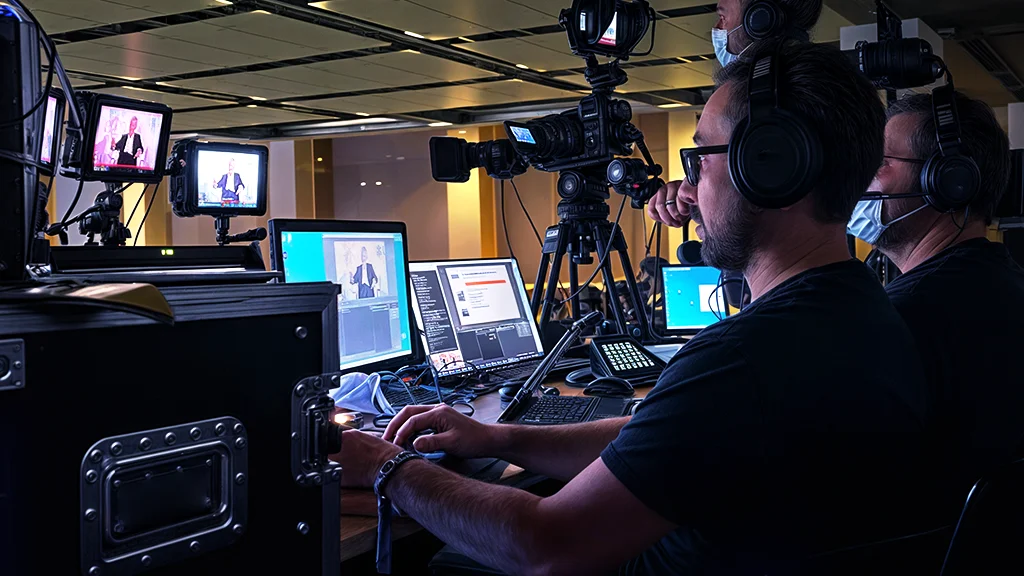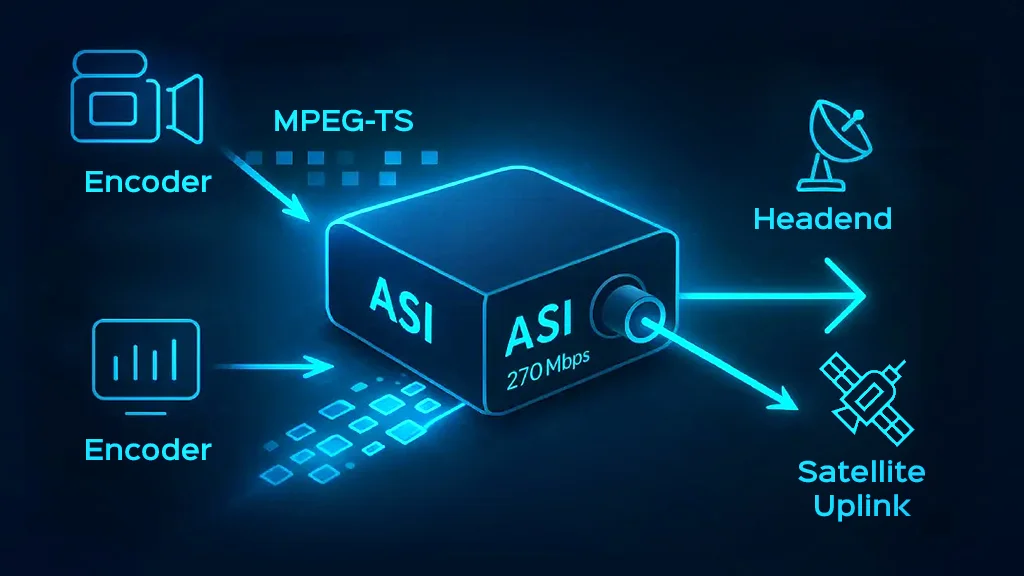
- Article
ASI in Broadcast Transport Streams: The Backbone of Digital TV Signal Distribution
Asynchronous Serial Interface (ASI) signals are pivotal in distributing digital television signals, especially within the broadcast infrastructure. This article examines the critical role of ASI in broadcast transport streams, highlighting its functionality, diverse applications, and inherent limitations. By evaluating ASI’s impact, professionals in the broadcasting field can make informed decisions about digital signal distribution methods, ultimately ensuring a more efficient and reliable broadcasting experience.
Explanation of ASI signals
ASI, which stands for Asynchronous Serial Interface, is a technique used to transmit MPEG Transport Streams (MPEG-TS) via coaxial or fiber-optic cables. It is widely employed in broadcasting and cable systems to transfer compressed audio and video data. In simple terms, the ASI signal contains fully compressed video stream which is ready for distribution. The standard data rate for ASI signals is 270 Mbps, enabling the transfer of high-quality MPEG-TS data streams, including multiple audio and video services along with their metadata.
Why is ASI Used in Broadcast?
ASI is widely used in broadcast transport streams for several important reasons:
Compatibility with MPEG-TS
The purpose of ASI is to transmit the MPEG Transport Streams, which serve as the standard for video and audio encoding and transmission. This compatibility makes ASI a natural choice for broadcasting applications.
Asynchronous Operation
The asynchronous nature of ASI means that data can be sent without the need for synchronized clock between the transmitter and receiver, enabling more flexible signal processing and equipment design.
Robustness and Reliability
ASI signals are transmitted over coaxial or fiber optic cables, which are less susceptible to electromagnetic interference compared to other types of cables. This robustness ensures reliable data transmission, essential for broadcast quality.
Error Detection and Correction
ASI contains error detection mechanisms, which helps maintaining data integrity during transmission. A critical aspect when dealing with high-quality audio and video signals.
Cost-Effectiveness
The use of coaxial cables is economical for many broadcasting environments. Additionally, the simplicity of the ASI protocol reduces the complexity and cost of overall system.
Industry Standard
ASI is recognized as an industry–standard in professional broadcasting. Its widespread adoption ensures broadcasters already have compatible equipment and infrastructure, simplifying integration and scaling.
ASI in the Broadcast Transport Stream Chain
The ASI transport stream plays an essential role in the broadcast transport streams chain by facilitating the transmission of MPEG Transport Streams containing audio, video, and additional data. The process begins with content creation, where material is captured from various sources such as cameras and microphones.
Once the content is generated, it undergoes encoding and compression, during which audio and video signals are processed using codecs like H.264 for video and AAC for audio. This step reduces the data size while maintaining quality, resulting in the creation of MPEG Transport Streams. The encoded audio and video data is then packaged into these transport streams, allowing multiple streams to be combined into a single, coherent output.
Next is transmission via ASI, where the multiplexed MPEG-TS is transmitted using ASI to the headend. This step is crucial for ensuring high-quality signal transmission with minimal loss. At the headend, the MPEG-TS is processed and distributed to transmitters, which leads into broadcasting the content to viewers. Finally, the transmitted signals arrive at viewers’ televisions and devices, enabling them to watch the content.
On the other hand, the path of ASI from the headend back into the production cycle involves receiving MPEG-TS signals, which may arrive from multiple sources or other broadcasters. Upon arrival, the MPEG-TS undergoes preprocessing and demultiplexing at the headend, where the combined audio and video streams are separated for individual processing.
After demultiplexing, the particular audio and video streams can be edited, enhanced, or utilized for dubbing, enabling their reuse in future broadcasts. Ultimately, the processed content is re-integrated into the broadcasting cycle and sent back to viewers, either as live content or recorded program.
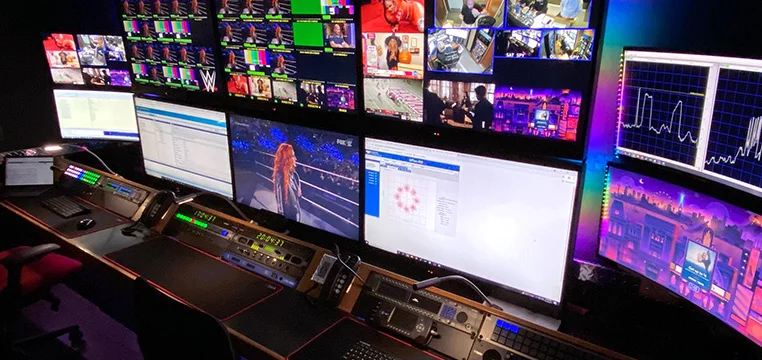
DVB-ASI and digital video broadcasting
DVB-ASI is a specific standard derived from the ASI protocol established by the DVB Project. It defines how the ASI interface should be used specifically for digital video broadcasting systems.
DVB-ASI encompasses a set of protocols and specifications which are designed to ensure interoperability between different digital broadcasting devices and systems.
It also defines requirements for encapsulating and transferring MPEG-TS data. When a device supports “DVB-ASI input,” it indicates that appliance is capable of receiving and processing signals which conform to the DVB-ASI standards, ensuring compatibility with equipment designed for digital broadcasting purposes.
Limitations and When to Consider Alternatives for ASI Signals
Despite its widespread acceptance and many advantages, ASI does have limitations that can compel broadcasters to explore alternative technologies:
Distance Limitations: The effective transmission range for ASI is typically limited over standard coaxial cables. Beyond this limitation, signal degradation occurs, necessitating repeaters or alternate methods for long-range transmission.
Incompatibility with IP Networks: As broadcasting increasingly shifts towards IP-based ecosystems, ASI’s lack of native IP support becomes a significant drawback. Modern broadcasting demands integrating legacy systems with IP infrastructure for greater flexibility.
Scalability Concerns: With the rise of high-definition (HD), ultra-high-definition (UHD), and multi-channel audio formats. ASI may struggle to support higher bandwidth demands without substantial infrastructure upgrades.
Alternatives to ASI
Given these limitations, broadcasters might consider the following alternatives:
IP-based Transport Methods: Protocols like Real-time Transport Protocol (RTP) and User Datagram Protocol (UDP) enable broadcasters to leverage existing IP infrastructures while providing scalable and flexible transmission options.
Serial Digital Interface (SDI): For high-quality uncompressed video transmission over longer distances, using SDI can offer improved performance with higher bandwidth capabilities.
MPEG-TS Over IP: This method maintains broadcasting transport stream capabilities while utilizing robust IP technology, providing the advantages of both systems.
Advanced Network Solutions: Employing technologies like Jingle Over IP (JoIP), which can manage multiple streams effectively over networked environments, may also be a viable alternative.
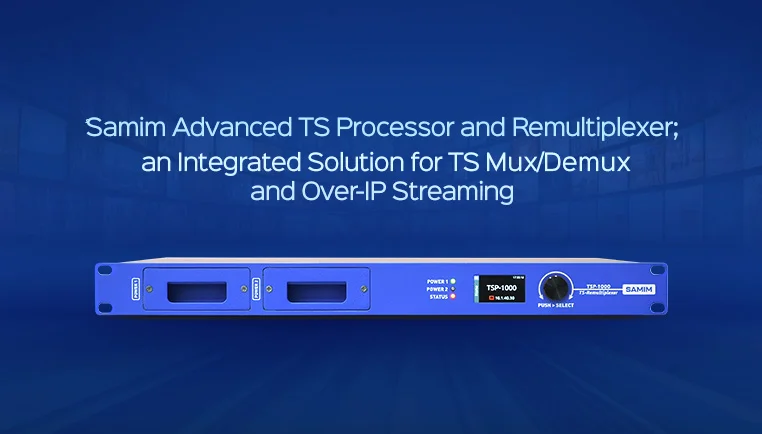
Samim Group: Advanced Solutions for Broadcasting
Samim Group delivers broadcast solutions for optimized ASI signal handling and premium-quality compressed media transmission. Their offerings include:
DVB-ASI Supported Equipment: Samim’s state-of-the-art equipment ensures seamless integration with existing broadcasting systems, efficiently managing multiple streams through advanced multiplexing capabilities.
Signal Boosters and Repeaters: Designed to extend the distance over which ASI signals can be transmitted without degradation, ensuring reliable signal delivery across various environments.
Redundant Systems: Implementing redundancy in critical areas guarantees continuous signal availability, crucial during live events.
Integrated Monitoring Tools: These tools provide real-time monitoring of ASI signals, enabling early detection of potential issues, thus maintaining high broadcast quality standards.
Expert Consultation and Support: Samim Group offers comprehensive consulting and technical support to guide clients through implementing and maintaining their broadcasting systems.
With built-in error detection and correction, broadcasters can rely on consistent, high-quality signal delivery, even during live broadcasts. This combination of advanced technology and dedicated support empowers broadcasters to deliver exceptional content to their audiences confidently.





